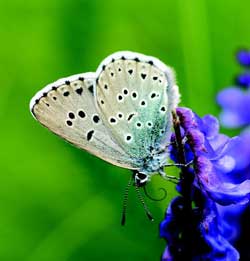How to save Europe's most threatened butterflies

Euphydryas aurinia (Marsh Fritillary ): declining across Europe. The chief threat in lowland grasslands is from overgrazing or cutting. It prefers extensive cattle grazing that creates a tussocky sward in which the main food-plant, Succisa pratensis (Devil’s-bit Scabious) and caterpillars can survive. Foto: Chris van Swaay<br>
Each Member State has a responsibility to conserve these species. The new report will provide crucial information on how to achieve this goal and meet their international biodiversity targets.
The report entitled “Dos and don'ts for butterflies of the Habitats Directive of the European Union” was published in the form of an “Applied Conservation” paper in the newly launched open-access journal Nature Conservation (press release on the journal launch). It includes detailed accounts of each species, their habitat requirements and food-plants, as well as a list of dos and don'ts in the management of their habitats.
European butterflies are under huge threat and almost 10% are now threatened with extinction. The European grassland indicator shows that the abundance of 17 characteristic butterflies has declined by over 70% in the last 15 years. The main reasons for the declines are habitat loss and incorrect management. Many habitats are now either abandoned from agriculture, allowing them to become overgrown with scrub, while others are too intensively managed. The new publication is thus a pivotal step to get remaining habitats better managed.
Butterflies are sensitive indicators of the environment and populations respond very quickly to habitat change. Management for butterflies will help ensure the survival of a wide range of other insects, which form the bedrock of European biodiversity. The guidelines will help ensure that European habitats are managed in a sustainable way that helps the survival of humans as well as wildlife.
The lead author, Chris van Swaay of Dutch Butterfly Conservation said “Managing habitats in the correct way is the single most important issue affecting the survival of European butterflies. This is the first time that practical information has been brought together to address the issue. We hope the advice will be taken up urgently across Europe to help save these beautiful species from extinction.”
Klaus Henle of UFZ (Germany) who established the new journal in collaboration with Lyubomir Penev at Pensoft (Bulgaria) within the European Union's FP7 project SCALES says “Biodiversity loss is one of the most important topics facing the future of our planet. Our new open access journal Nature Conservation is intended to make scientific information freely available to help conserve nature and create a healthy world for everyone. The journal aims particularly at facilitating better interaction between scientists and practitioners and its major goal is to support synergistic interactions among scientists, policy-makers, and managers.”
http://www.ufz.de/index.php?en=30346
Original Source:
van Swaay C, Collins C, Dušej G, Maes D, Munguira ML, Rakosy L, Ryrholm N, Šašiæ M, Settele J, Thomas JA, Verovnik R, Verstrael T, Warren M, Wiemers M, Wynhoff I (2012) Dos and Don'ts for butterflies of the Habitats Directive of the European Union. Nature Conservation 1: 73-153. doi: 10.3897/natureconservation.1.2786
Posted by Pensoft Publishers.
Contact persons:
Overall: Chris van Swaay (chris.vanswaay@vlinderstichting.nl)
Germany: Martin Wiemers (Martin.Wiemers@ufz.de), Josef Settele (Josef.Settele@ufz.de)
Media Contact
More Information:
http://www.ufz.deAll latest news from the category: Ecology, The Environment and Conservation
This complex theme deals primarily with interactions between organisms and the environmental factors that impact them, but to a greater extent between individual inanimate environmental factors.
innovations-report offers informative reports and articles on topics such as climate protection, landscape conservation, ecological systems, wildlife and nature parks and ecosystem efficiency and balance.
Newest articles

Properties of new materials for microchips
… can now be measured well. Reseachers of Delft University of Technology demonstrated measuring performance properties of ultrathin silicon membranes. Making ever smaller and more powerful chips requires new ultrathin…

Floating solar’s potential
… to support sustainable development by addressing climate, water, and energy goals holistically. A new study published this week in Nature Energy raises the potential for floating solar photovoltaics (FPV)…

Skyrmions move at record speeds
… a step towards the computing of the future. An international research team led by scientists from the CNRS1 has discovered that the magnetic nanobubbles2 known as skyrmions can be…





















